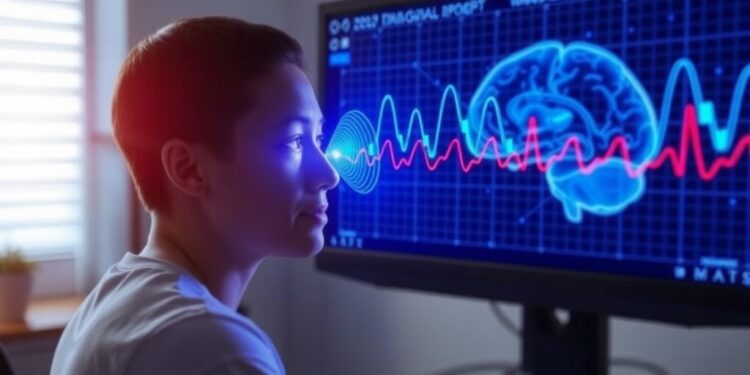
Doctors on the verge of breaking new ground in epilepsy diagnostics have found remarkable success utilizing a novel tool that reinterprets routine electroencephalogram (EEG) tests. This potentially transformative technology aims to cut down on epilepsy misdiagnoses by as much as 70%, according to a recent study conducted by researchers at Johns Hopkins University. The tool unveils hidden signatures of epilepsy that often elude clinicians, even in EEG results that are considered normal.
Among the various challenges faced in diagnosing epilepsy is the fact that approximately 30% of cases worldwide encounter false positives, leading to unnecessary treatments and distress for patients. These misdiagnoses can result in harmful side effects from prescribed anti-seizure medications, as well as significant lifestyle limitations such as driving restrictions. The emerging technology promises not just to lessen these occurrences but also to enhance the overall quality of life for patients by facilitating more accurate diagnoses and treatments.
One of the principal researchers, Sridevi V. Sarma, a professor of biomedical engineering at Johns Hopkins, has expressed the significant impact this tool could have on the speed and accuracy of diagnosis. Typically, epilepsy patients undergo multiple EEG tests before precise abnormalities are identified, a frustrating and time-consuming process. With this new approach, Sarma asserts that clinicians can arrive at a correct diagnosis three times faster than conventional techniques allow.
The tool, dubbed EpiScalp, applies advanced algorithms developed from dynamic network models to analyze brainwave activity captured during routine EEG tests. This reanalysis aims to uncover patterns that indicate the presence of epilepsy, transforming what was once considered uninformative data into actionable insights. Underlying the study is the intriguing hypothesis that certain regions in the brain act as natural suppressors of seizures, functioning similarly to an immune response that inhibits the onset of epileptic activity.
Research efforts included studying 198 epilepsy patients across several major medical centers, including Johns Hopkins Hospital and University of Pittsburgh Medical Center. The results were compelling; EpiScalp significantly reduced potential misdiagnoses in previously flagged cases of epilepsy from 54% down to an impressive 17%. This level of efficacy underscores the potential implications for clinical practice, where accurate identification of the condition can lead to swift, effective treatment pathways.
The ramifications of misdiagnosis extend beyond the realm of medications. Many individuals suffering from non-epileptic seizures often find themselves on anti-seizure medications prescribed as a precaution against the misdiagnosis of epilepsy. However, with tools like EpiScalp gaining traction, it becomes increasingly possible to distinguish between epilepsy and these mimicking conditions, allowing for better-targeted treatments that do not involve unnecessary medication.
Sarma and her team recognized that traditional EEG interpretations often suffer from subjective bias, due in part to the complexity of analyzing noisy brain signals. Given that seizures typically do not present during a standard 20-40 minute EEG session, the challenge of accurately diagnosing epilepsy is no small feat. EpiScalp was designed with these limitations in mind, utilizing a broader analysis of how various brain regions interact through neural networks rather than focusing solely on isolated signals.
Primary author Patrick Myers, who is a doctoral student under Sarma, explained that examining the interaction among different brain ‘nodes’ can unveil a nuanced understanding of epilepsy. The pattern reveals instances where certain nodes showed independence from the neural network, insights that are critical for distinguishing healthy brain architecture from that indicative of epilepsy. In essence, EpiScalp digs deeper into the interaction between nodes, offering a clearer picture of the underlying brain dynamics.
The researchers’ findings not only hold promise for enhancing diagnostic accuracy but also contribute to an ongoing conversation about the importance of precision medicine, tailored treatments, and the potential for quicker recovery times. As the team prepares to conduct further validation studies across additional epilepsy treatment centers, the anticipation surrounding EpiScalp continues to grow.
Moreover, attention is also directed toward the implications of such advancements on the healthcare landscape, particularly regarding policy changes related to epilepsy diagnosis and treatment. As more patients receive precise diagnoses, there is potential for a shift in how healthcare providers approach these cases. With EpiScalp leading the charge, an era of improved diagnostics for epilepsy may well be on the horizon.
Ultimately, the journey for EpiScalp is just beginning. The research team has already filed a patent for this innovative technology, which reflects the gravity of their findings and the desire to usher in a new standard of care for epilepsy handling. As the field of neuroscience evolves with these breakthroughs, the impact on patient care could be monumental, marking a significant departure from “one-size-fits-all” approaches towards more personalized medicine strategies.
With the momentum gained from this research, the cross-disciplinary collaboration at Johns Hopkins exemplifies the significant strides being made in neuroscience and diagnostic technology. The excitement is palpable as both clinicians and patients look forward to a future where epilepsy diagnosis is swift, accurate, and profoundly more humane.
In summary, EpiScalp presents groundbreaking advancements in the field of epilepsy diagnosis. The possibility of reducing misdiagnosis rates significantly would not only improve patient outcomes and reduce unnecessary healthcare costs but also enhance the overall well-being of those impacted by epilepsy. As more research emerges and the technology undergoes further validation, the medical community eagerly anticipates the changes this innovation could bring to patient care.
Subject of Research: Epilepsy Diagnosis
Article Title: Diagnosing Epilepsy with Normal Interictal EEG Using Dynamic Network Models
News Publication Date: 16-Jan-2025
Web References: Annals of Neurology
References: N/A
Image Credits: N/A
Keywords
Epilepsy, Seizures, EEG activity, Neural networks, Medical technology, Immune response, False positives.
Tags: Clinical NeuroscienceDynamic Network ModelsEEG TechnologyEpilepsy DiagnosisEpiScalp TechnologyHealthcare InnovationJohns Hopkins ResearchMedical Misdiagnosis ReductionNeural Network AnalysisPatient Care ImprovementPrecision medicineSeizure Detection Algorithms





